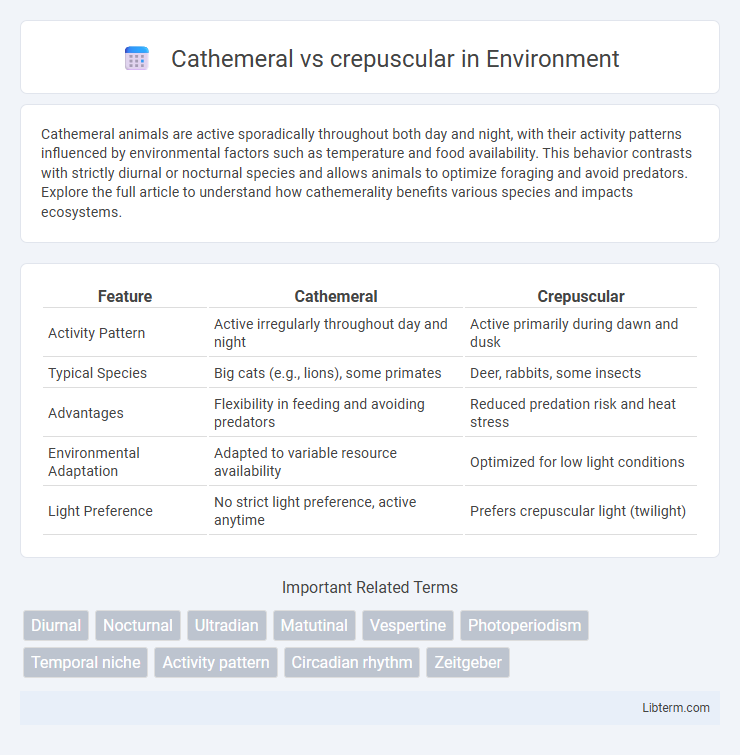Cathemeral animals are active sporadically throughout both day and night, with their activity patterns influenced by environmental factors such as temperature and food availability. This behavior contrasts with strictly diurnal or nocturnal species and allows animals to optimize foraging and avoid predators. Explore the full article to understand how cathemerality benefits various species and impacts ecosystems.
Table of Comparison
| Feature | Cathemeral | Crepuscular |
|---|---|---|
| Activity Pattern | Active irregularly throughout day and night | Active primarily during dawn and dusk |
| Typical Species | Big cats (e.g., lions), some primates | Deer, rabbits, some insects |
| Advantages | Flexibility in feeding and avoiding predators | Reduced predation risk and heat stress |
| Environmental Adaptation | Adapted to variable resource availability | Optimized for low light conditions |
| Light Preference | No strict light preference, active anytime | Prefers crepuscular light (twilight) |
Understanding Cathemeral and Crepuscular Activity
Cathemeral animals display irregular activity patterns, being active both day and night, unlike crepuscular animals that restrict their activity primarily to twilight periods at dawn and dusk. This distinction is crucial for understanding species behavior, habitat adaptation, and ecological niche occupation. Studies reveal cathemerality offers flexibility to avoid predators and exploit resources, while crepuscular habits capitalize on reduced competition and optimal environmental conditions during low-light times.
Defining Cathemeral: Around-the-Clock Activity
Cathemeral animals exhibit irregular activity patterns, being active sporadically throughout the 24-hour day without a fixed schedule, unlike crepuscular species that are primarily active during twilight periods at dawn and dusk. This around-the-clock activity allows cathemeral animals to exploit resources and avoid predators by varying their active times. Examples include certain lemurs and big cats, which adapt their behavior based on environmental conditions and resource availability.
What Does Crepuscular Mean?
Crepuscular animals are primarily active during twilight periods at dawn and dusk, taking advantage of low light conditions to forage and avoid predators. This behavior contrasts with cathemeral species, which display irregular activity cycles throughout day and night without a consistent pattern tied to light levels. Understanding crepuscular activity helps explain adaptations in vision, predation, and habitat use that optimize survival during these transitional times.
Key Differences Between Cathemeral and Crepuscular Animals
Cathemeral animals exhibit irregular activity patterns throughout the 24-hour day and night cycle, while crepuscular animals are primarily active during twilight periods at dawn and dusk. Cathemeral species, such as some lemurs and big cats, adapt their behavior based on environmental conditions, whereas crepuscular species like deer and rabbits have evolved to optimize low-light visibility and predator avoidance during specific times. The key difference lies in their temporal activity distribution, with cathemeral animals displaying flexibility and crepuscular animals showing concentrated activity peaks.
Evolutionary Advantages of Cathemeral Behavior
Cathemeral animals exhibit activity patterns distributed throughout the 24-hour cycle, offering evolutionary advantages in resource acquisition by maximizing foraging opportunities during both day and night. This flexible temporal niche reduces competition and predation risks compared to strictly crepuscular species, which are active only during dawn and dusk. The cathemeral lifestyle enhances adaptability to environmental changes, increasing survival rates by exploiting diverse ecological conditions.
Survival Benefits of Crepuscular Activity
Crepuscular animals, active primarily during dawn and dusk, gain survival advantages by avoiding peak predator activity and extreme daytime temperatures, enhancing their ability to forage safely. This temporal niche reduces competition for resources compared to cathemeral species that are active sporadically throughout the 24-hour cycle. The synchronization of crepuscular activity with low light conditions improves camouflage, increasing protection from predators and optimizing hunting efficiency.
Cathemeral vs. Crepuscular: Habitat and Adaptation
Cathemeral animals exhibit activity patterns distributed irregularly throughout the 24-hour day and night cycle, adapting to diverse habitats such as tropical forests and savannas where food availability and predation risk fluctuate. Crepuscular species, active primarily during dawn and dusk, have evolved specialized vision and behavioral strategies optimized for low-light conditions in habitats like temperate woodlands and wetlands. The distinct temporal niches of cathemeral and crepuscular animals reflect adaptive responses to environmental pressures influencing foraging efficiency and predator avoidance.
Animal Examples: Cathemeral Species
Cathemeral animals, such as jaguars (Panthera onca), green iguanas (Iguana iguana), and elephant seals (Mirounga angustirostris), exhibit irregular activity periods throughout both day and night, adapting to varying environmental conditions and resource availability. Unlike crepuscular species like deer and rabbits that are active primarily during dawn and dusk, cathemeral species optimize foraging and predator avoidance by spreading their activity cycles across a 24-hour period. This behavioral flexibility enhances survival in habitats with fluctuating light levels and predator pressures.
Animal Examples: Crepuscular Species
Crepuscular species such as white-tailed deer, rabbits, and many species of bats are primarily active during twilight periods--dawn and dusk--allowing them to avoid extreme daytime heat and nocturnal predators. This behavior contrasts with cathemeral animals like some lemurs and big cats that exhibit irregular activity patterns throughout the 24-hour cycle, both day and night. Crepuscular activity optimizes energy efficiency and predator avoidance in specific ecological niches.
Conclusion: Choosing the Right Activity Pattern
Cathemeral animals exhibit activity that is sporadically distributed throughout the 24-hour cycle, while crepuscular species are active primarily during twilight periods at dawn and dusk. Selecting an activity pattern depends on environmental factors such as predator presence, resource availability, and temperature fluctuations to optimize survival and energy efficiency. Adapting behavior to either cathemeral or crepuscular rhythms enhances an animal's ability to thrive within its ecological niche.
Cathemeral Infographic

 libterm.com
libterm.com